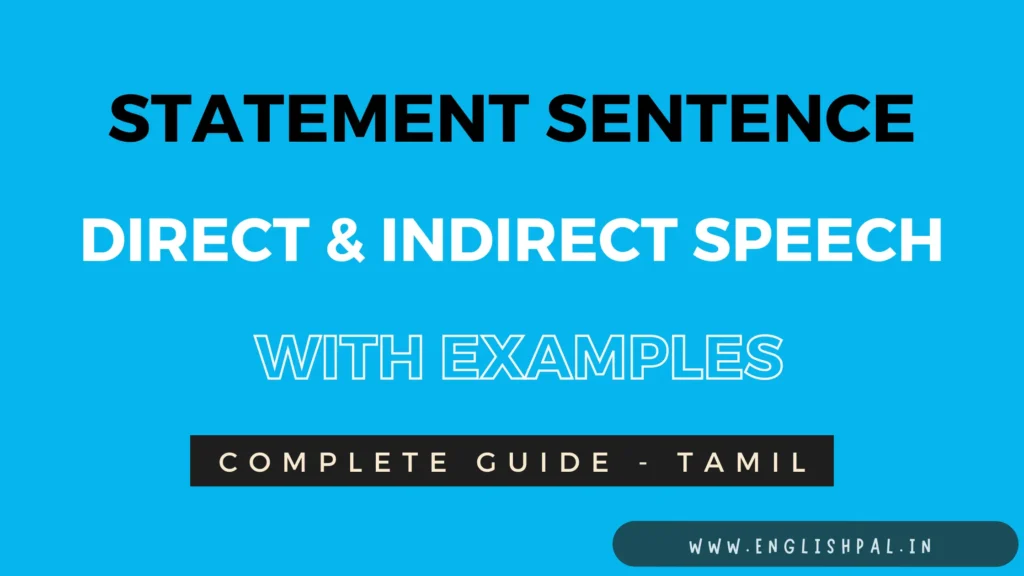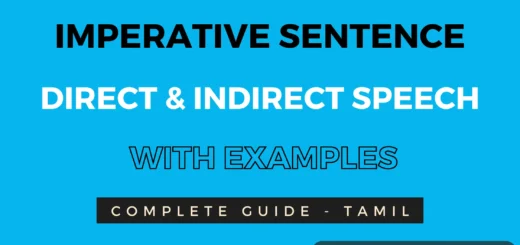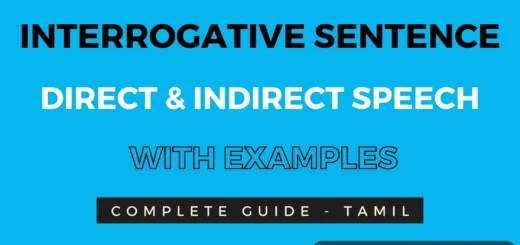Statement sentences – Direct to indirect speech with examples in Tamil
Statement sentence
Statement sentence ஐ தமிழில் சாதாரண வாக்கியம் என அழைக்கப்படுகிறது. நாம் ஒரு விவரத்தை சாதரணமாக கூற அல்லது உறுதிமொழியாக கூற இந்த வகை வாக்கியங்கள் உதவுகின்றன.
உலக உண்மைகள் போன்றவை இந்த Statement sentence இல் நாம் குறிப்பிடுவோம்.
பல வகை வாக்கியங்களை நாம் படிக்கிறோம், எழுதுகிறோம், பேசுகிறோம். ஆனால் அவற்றில் எதை நாம் எதை வைத்து அந்த வாக்கியத்தை சாதாரண வாக்கியம் என தெரிந்து கொள்வது? இதனை நம்மால் எளிதல் ஞாபகம் வைத்துக்கொள்ள முடியும். ஒரு வாக்கியமானது subject (noun, Pronoun) இல் தொடங்கி முற்றுப்புள்ளியில் முடிந்தால் அது statement sentence ஆகும்.
statement sentence ஆனது Declarative sentence அல்லது assertive sentence எனவும் அழைக்கப்படுகிறது.

Statement sentence – Direct speech ஐ Indirect speech ஆக மாற்றுவது எப்படி?
Statement sentence னை Direct speech ஐ Indirect speech ஆக மாற்ற என்னென்ன செய்யவேண்டும் என்பதை காண்போம்.
Step 1 – முதலில் எவ்வகை வாக்கியம் என கண்டறிந்து அதன் reporting verb ஐ மாற்ற வேண்டும்.
Statement sentence – சாதாரண வாக்கியம்
Reporting verb
- Says – says
- Says to – tells
- Said – said
- Said to – told
Step 2 – பின்பு அந்த வாக்கியத்தில் உள்ள quotation mark ஐயும் comma வும் நீக்க வேண்டும்.
Step 3 – quotation mark க்கும் comma க்கும் பதிலாக வாக்கியத்தின் வகைக்கு ஏற்ப சரியான conjunction ஐ உபயோகிக்க வேண்டும்.
statement sentence ஐ indirect speech க்கு மாற்றும் போது that எனும் Conjunction ஐ உபயோகிக்க வேண்டும்.
conjunctions பற்றி தெளிவாக அறிய Conjunctions (இணைப்புச் சொற்கள்) with Examples in Tamil
Step 4 – பின்பு அந்த வாக்கியத்தில் உள்ள pronoun களை மாற்ற வேண்டும். யார் யார்தான் பேசுகிறார்கள் என்கின்ற தெளிவு அவசியம். அதனால் எந்த பிழையும் இல்லாமல் சரியாக மாற்ற இயலும்.
Pronouns என்றால் என்ன அதன் வகைகள் அதை எப்படி உபயோகிப்பது என்பது பற்றி தெரிந்து கொள்ள Pronoun (பிரதிப் பெயர்ச்சொல்) & it types in Tamil with examples
Step 5 – வாக்கியத்தில் உள்ள tense ஐ சரியாக மாற்றி அதன் பொருள் மாறாமல் உபயோகிக்க வேண்டும்.
tense பற்றியும் அதன் வகைகள் எப்படி காலத்தை, வினைச்சொல்லை பொறுத்து மாறும் என்பதை எடுத்துக்காட்டுகளுடன் விளக்கப்பட்டுள்ளது. அதனை படிக்க All 12 Tenses in Tamil with examples
Step 6 – பின்பு சரியான பொருள் தரக்கூடிய adverbial ஐ உபயோகிக்க வேண்டும்.
மேலே கூறிய 6 steps உம் அனைத்து வாக்கியங்களுக்கும் பொருந்தாது. சில வாக்கியங்களுக்கு அனைத்து steps ம் வரும். சிலவற்றிற்கு வராது. அது அந்த வாக்கியம் அதில் உபயோகபடுதப்பட்டுள்ள வார்த்தைகளைப் பொருத்து மட்டுமே அமையும்.
பின்வரும் எடுத்துக்காட்டுகளில் எவ்வாறு indirect speech ஆக மாற்றுவது, அவற்றின்pronoun, Tense, conjunction, adverbial எப்படி மாறும் என்பதை காணலாம்.
Examples
நாம் மேலே எப்படி மாற்றுவது என்பதை படிப்படியாக விளக்கினோம் அல்லவா? அதே போல் கீழே கொடுக்கப்பட்டு இருக்கும் எடுத்துக்காட்டுகளை அந்த ஒவ்வொரு படிகளையும் குறிப்பிட்டு விளக்கியுள்ளோம். அவற்றை காணுங்கள்.
Example 1
He says, “I’ll call you later.”
நாம் மேலே கூறிய ஒவ்வொரு steps படி மாற்றலாம்.
மேலே கூறப்பட்டுள்ள வாக்கியமானது I எனும் noun இல் ஆரம்பித்து முற்றுப்புள்ளியுடன் முடிந்துள்ளது. எனவே இது statement வாக்கியம்.
- reporting verb இங்கு says. மேலே கூறப்பட்டுள்ளதன் படி says வந்தால் நாம் says என மாற்ற வேண்டும். நாம் statement வாக்கியத்தின் tense ஐ மாற்ற வேண்டியது இல்லை. – He says
- quotation mark க்கும் comma க்கும் நீக்கி statement வாக்கியத்தின் conjunction ஆன that ஐ உபயோகிக்க வேண்டும் – he says that
- இங்கு reporting verb says என present tense இல் உள்ளதால் வாக்கியத்தின் tense ஐ மாற்ற வேண்டியது இல்லை. – he says that
- இங்கு I என்பது அந்த சொல்லும் நபரை குறிப்பிடுகிறது. எனவே I என்ற noun ஆனது he என மாறும். – he says that he calls you
- இங்கு later என்ற adverbial உபயோகப்படுத்தப்பட்டு உள்ளது. later எனபது மாறாது. later என்றே இருக்கும். – He says that he will call you later.
Indirect speech – He says that he will call you later.
Example 2
Haran said, “I am hungry.”
இந்த வாக்கியமானது I எனும் noun இல் ஆரம்பித்து முற்றுப்புள்ளியுடன் முடிந்துள்ளது. எனவே இது statement வாக்கியம் ஆகும்.
- reporting verb இங்கு said. எனவே said என்பதை உபயோகிக்க வேண்டும். மேலும் statement வாக்கியத்தின் tense ஐ மாற்ற வேண்டும். – Haran said
- quotation mark க்கும் comma க்கும் நீக்கி statement வாக்கியத்தின் conjunction ஆன that ஐ உபயோகிக்க வேண்டும் – Haran said that
- haran என்னும் நபர் அவரை பற்றி கூறுகிறார். எனவே I ஆனது he என மாறும். – Haran said that he
- said வந்துள்ளதால் நாம் tense ஐ மாற்ற வேண்டும். – Haran said that he was hungry.
- இங்கு adverbial எதுவும் உபயோகிக்கவில்லை. எனவே அதனை மாற்ற தேவை இல்லை.
Indirect speech – Haran said that he was hungry.
Note
ஒரு வாக்கியத்தில் main verb மற்றும் auxiliary verb என இரண்டும் வரும்போது நாம் indirect speech ஆக மாற்றும் போது auxiliary verb இன் tense ஐ மட்டும் மாற்றினால் போதுமானது.
Example 3
Dhanush said to anirudh, “I will play with you this week”
மேலே உள்ள எடுத்துக்காட்டை எப்படி indirect speech ஆகா மாற்றலாம் என காண்போம்.
- இது ஒரு statement sentence. said to என reporting verb வந்துள்ளது. எனவே அதனை நாம் told என மாற்ற வேண்டும். say to என வந்து இருந்தால் tell என மாற்ற வேண்டும். – Dhanush told anirudh
- quotation mark க்கும் comma க்கும் நீக்கி statement வாக்கியத்தின் conjunction ஆன that ஐ உபயோகிக்க வேண்டும். – Dhanush told anirudh that
- Pronoun ஐ மாற்ற வேண்டும். – Dhanush told anirudh that he
- main verb மற்றும் auxiliary verb என இரண்டும் இந்த வாக்கியத்தில் வந்துள்ளது. எனவே நாம் auxiliary verb ஐ மட்டும் மாற்றினால் போதும். – Dhanush told anirudh that he would play with
- you என்பது him என மாறும். – Dhanush told anirudh that he would play with him
- adverbial change செய்ய வேண்டும்.this week என்பது that week என மாறும். – Dhanush told Anirudh that he would play with him that week.
Direct speech – Dhanush said to anirudh, “I will play with you this week”
Indirect speech – Dhanush told Anirudh that he would play with him that week.
இனி வரும் எடுத்துக்காட்டுகளில் ஒவ்வொரு tense ம் indirect speech ஆக மாற்றும் போது எப்படி மற்றொரு tense ஆக மாறுகிறது என காண்போம்.
Example 4 – Present continuous tense to past continuous tense
Raj said, “he is watching a web series.”
- noun இல் தொடங்கி முற்றுப்புள்ளியை கொண்டு முடிந்துள்ளது. எனவே இது statement sentence. – Raj said
- Quotation mark க்கும் comma க்கும் நீக்கி that ஐ உபயோகிக்க வேண்டும் – Raj said that
- he என்னும் pronoun வேறு ஒருவரை குறிப்பிடுவதால் he என்னும் pronoun ஐயே உபயோகிப்போம். – Raj said that he
- வாக்கியமானது Present continuous tense இல் உள்ளது. அதனை past continuous tense ஆக மாற்ற வேண்டும். – Raj said that he was watching a web series.
- இந்த sentence இல் எந்த adverbial உம் உபயோகப்படுத்தவில்லை.
Indirect speech – Raj said that he was watching a web series.
Example 5 – Present perfect tense to past perfect tense
Raj said to Ramu, “I have completed my project”
- Reporting verb ஐ மாற்ற வேண்டும். said to to told – Raj told Ramu
- Quotation mark க்கும் comma க்கும் நீக்கி that ஐ உபயோகிக்கவும். – Raj told Ramu that
- Pronoun ஐ அதன் பொருள் மாறாமல் மாற்ற வேண்டும். I என்பது he எனவும், my என்பது him எனவும் மாறும். – Raj told Ramu that he
- வாக்கியமானது Present perfect tense இல் உள்ளது. அதனை நாம் past perfect tense ஆக மாற்ற வேண்டும். – Raj told Ramu that he had completed his project.
Indirect speech – Raj told Ramu that he had completed his project.
Example 6 – Present perfect continuous tense to past perfect continuous tense
Ravi said to HR, “I have been working in my current company for 2 years.”
Reporting verb ஐ மாற்ற வேண்டும். said to to told – Ravi told HR
Quotation mark க்கும் comma க்கும் நீக்கி that ஐ உபயோகிக்கவும். – Ravi told HR that
Pronoun I என்பது he எனவும், my என்பது his எனவும் மாறும். – Ravi told HR that he
வாக்கியமானது Present perfect continuous tense இல் உள்ளது. அதனை நாம் past perfect continuous tense ஆக மாற்ற வேண்டும். – Ravi told HR that he had been working for his current company for 2 years.
Indirect speech – Ravi told HR that he had been working for his current company for 2 years.
Example 7 – Simple past tense to past perfect tense
She said, “I went to the hospital.”
- Reporting verb ஐ மாற்ற வேண்டும். said to said – she said
- Quotation mark க்கும் comma க்கும் நீக்கி that ஐ உபயோகிக்கவும். – She said that
- Pronoun I என்பது she என மாறும். – She said that she
- வாக்கியமானது Simple past tense இல் உள்ளது. அதனை நாம் past perfect tense ஆக மாற்ற வேண்டும். – She said that she had gone to the hospital.
Indirect speech – She said that she had gone to the hospital.
Direct & Indirect Speech மற்றும் அதன் மற்ற வகைகளை தெரிந்து கொள்ள
Direct speech and Indirect speech in Tamil
Interrogative sentences – Direct speech & indirect speech in Tamil
Example 8 – Past continuous tense to past perfect continuous tense
Direct speech – Rani said to Vani, “He was playing cricket.”
இங்கு said to வந்துள்ளதால் நாம் tense ஐ மாற்ற வேண்டும். இங்கு வாக்கியமானது Past continuous tense இல் வந்துள்ளது. அதனை past perfect continuous tense ஆக மாற்ற வேண்டும்.
மற்றபடி conjunction, pronoun change ஆகியவற்றை மாற்ற முந்தைய எடுத்துக்காட்டுக்களை காண்கவும்.
Indirect speech – Rani told Vani that he had been playing cricket.
Example 9 – Future continuous changes to conditional continuous
Direct speech – He said, “I will be playing cricket with my friends tomorrow.”
இங்கு said வந்துள்ளதால் நாம் tense ஐ மாற்ற வேண்டும். இங்கு வாக்கியமானது Future continuous tense இல் வந்துள்ளது. அதனை conditional continuous ஆக மாற்ற வேண்டும்.
மற்றபடி conjunction, pronoun change ஆகியவற்றை மாற்ற முந்தைய எடுத்துக்காட்டுக்களை காண்கவும்.
Indirect speech – He said that he would be playing cricket with his friends the next day.
Universal truths
பொதுவாக universal truths ஆனது simple present tense இன் கீழ் வரும். எனவே இவ்வகை வாக்கியங்கள் வரும் போது நாம் tense சம்பந்தமாக எதுவும் மாற்றத் தேவையில்லை.
Example
Direct speech – He said, “the sun rises in the east”
Indirect speech – He said that the sun rises in the east.
Conclusion
ஒரு சாதாரண வாக்கியத்தை நாம் எப்படி நாம் நேர்கூற்றில் இருந்து அயற்கூற்றாக மாற்றுவது என்பதை படிப்படியாக எடுத்துக்காட்டுகளுடன் தெளிவாக இந்த பதிவில் கண்டோம். நாம் இங்கு 10 வகை வாக்கியங்களை நாம் ஒவ்வொன்றாக நேர்கூற்றில் இருந்து எப்படி அயற்கூற்றுக்கு மாற்றுவது என்பதையும் கண்டோம். இதன் மூலம் உங்களுக்கு எந்த ஒரு சாதாரண வாக்கியத்தை தந்து அயற்கூற்றாக மாற்ற சொன்னாலும் உங்களால் மாற்ற முடியும் என நம்புகிறோம்.
உங்கள் கருத்துக்களை மற்றும் ஏதேனும் சந்தேகங்கள் இருப்பின் அதனை எங்களுக்கு comment இல் தெரிவியுங்கள். நாங்கள் உங்கள் சந்தேகங்களுக்கு பதில் அளிக்க ஆர்வமாக இருக்கிறோம்.
மற்ற வகை வாக்கியங்களை இங்கு நாம் மாற்றியதை போல எப்படி Direct speech இல் இருந்து Indirect speech ஆக மாற்றுவது என அடுத்தடுத்த பதிவுகளில் காண்போம்.



